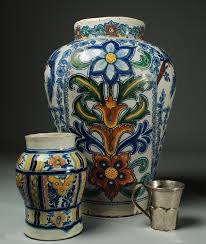Mexican antique vases are magnificent and owe their origin to indigenous cultures, such as Toltec, Mayan, Omlec and Aztec cultures. Each piece is endowed with the innate creativity of the artist. Read our guide for more facts and information…
The existence of vases dates back to thousands of years with the earliest evidence discovered in Mesopotamia. Crystal and glass were introduced by the Romans, who are known for their ornate enameled and stained glasses. The world-renowned Portland Vase embodies the glassmaking art of Roman times, depicting a violet-blue shade with cameo figures.
Early Mexican Vases
Mexico is renowned for its ancient pottery techniques and its Omlec culture is recognized as the ‘mother of Mesoamerican cultures.’ The artistry has been passed down generations and is still preserved in rural Mexico. Ranging from hammered copper to fired clay pots and sun baked terra cotta, Mexican vases render a unique depiction of ancient art. Terra cotta is a type of earthenware that has a characteristic porosity and permeability. Terra cotta jugs, vessels and vases are heavy with rich decorations. Traditional ceramic was brought to America in the sixteenth century due to the Spanish colonization. Popular as ‘majolica’ in Europe, tin-enameled earthenware flourished in Mexico in the colonial times. Despite Spanish inspiration, indigenous Mexicans created unimpaired styles leading to the evolution of Talavera earthenware. Talavera vases are handcrafted through an intricate process of glazing and firing to harden the enamel. Apart from utilitarian ware like plates, pots, bowls and barrels, artisans designed vases in exquisite shapes with fine decorations.
Mayan Vases
During the Mayan era, around 250-900 AD, painted ceramic vases were exchanged as gifts among the ruling class, and served to best reflect the artistic expertise of the time. The hieroglyphs and images on these vessels were hardly deciphered until recently, thanks to the advancements in chemical technology. Mayan vases provide valuable information about the economics, politics and society of the era. They were also used to serve food during feasts and the text engraved on the rim describes their purpose, such as ‘kakaw’ meaning chocolate, and beverages for cylinder-shaped vases. Vases also depict the classic culture of the Mayans and insinuate the royalty and palace life. Artists were held in high regard and skilled painters portrayed their mastery over the religious mythology and ideology of the Mayans, apart from using hieroglyphs for visual poetry.
Mexican Copper Vases
The indigenous Purépecha people of Santa Clara del Cobre in Mexico were involved in making copper objects ever since the pre-historic era. Though several objects, such as platters, bowls, crucifixes, forks and knives were made, the most artistic work pertained to the vase forms that were crafted in extraordinary shapes with varying surface textures. The vase-making process involved heating a huge sheet of copper over fire and then hammering it into shape on a form. Each piece was made from a single copper sheet with no joints. The size ranges from huge basin-like vessels to miniature vases that can be kept in dollhouses. The stunning solidity and elegant styles of these vases are matchless.
Mexican antique vases hold the finesse of indigenous cultures that has endured the ages. The extraordinary contours, delicate hand painting and strength have a timeless appeal and imbue a great value for them.





